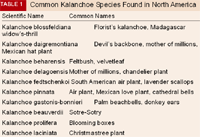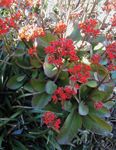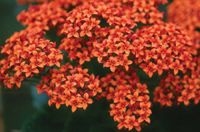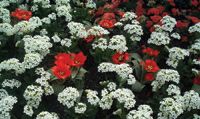Toxicology Brief: Kalanchoe species poisoning in pets
Kalanchoe is a genus of 150 to 200 plant species, most of which are native to southern Africa, Madagascar, and Australia.
Kalanchoe is a genus of 150 to 200 plant species, most of which are native to southern Africa, Madagascar, and Australia. In the past, the genus was divided into three genera: Kalanchoe, Bryophyllum, and Kitchingia. But today most botanists recognize it as one genus.1 In the United States, Kalanchoe species are primarily ornamentals and houseplants, but some have escaped cultivation and can be found in the wild, especially in Florida and Hawaii. Table 1 lists the most common Kalanchoe species found in North America.

Table 1 Common Kalanchoe Species Found in North America.
Plant characteristics
Although the plants vary, most Kalanchoe species are erect, growing shrubs (Figure 1). These perennial plants generally have thick, green, succulent foliage and clusters of small flowers (Figures 2 & 3). The plants are popular with florists because they can be forced to bloom at any time of the year, including holidays. Kalanchoe species' flowers can be many colors, but red, yellow, pink, orange, and white are the most common. The plants' bloom time is long; flower clusters can last for weeks to months. Most Kalanchoe species are easy to propagate from leaf or stem cuttings. Many species have plantlets (miniature plants at the end of flowering stems) growing in the notches of the leaf margins; these plantlets are so prolific that they sometimes escape into the wild.

Figure1. A Kalanchoe species shrub. Notice the thick green leaves and the small clusters of red flowers.
Toxicity
Kalanchoe species contain cardiac glycosides and are toxic to animals. In South Africa and Australia, where these plants are found in the wild, cattle and sheep poisonings are common.2-4 Toxicosis occurs primarily in the summer months because the flowers contain a much higher concentration of glycosides than the stems, leaves, or roots do.2 Although the toxic dose of Kalanchoe species in small animals is unknown, in calves the lethal dose is estimated to be 7 g of flowers/kg body weight or 40 g of leaves/kg body weight.2,3 In the United States, Kalanchoe species represent little risk to livestock because the plants are not commonly found in pastures. However, household pets, including dogs, cats, and birds, are susceptible because the plants are used in landscaping and kept as houseplants.

Figure 2. The flowers of the Kalanchoe blossfeldiana plant, the most common ornamental Kalanchoe species in the United States.
Mechanism of action
Kalanchoe species' toxicity is primarily due to a group of bufadienolide compounds, including bryotoxins, bryophyllins, and bersalgenins.1,5 Bufadienolides are cardiac glycosides that are similar to digitalis compounds. Inhibition of the cellular membrane sodium-potassium pump (Na+,K+-ATPase enzyme system) produces the cardiotoxic effects. In the heart, this system pumps sodium out of the cell in exchange for potassium. When the pump is inhibited, intracellular sodium concentrations begin to increase, and potassium concentrations decrease. The increased intracellular sodium can be exchanged through the sodium-calcium exchanger for calcium, which improves contractility. Because of this effect, these glycosides (e.g. digoxin) can be used pharmacologically as positive inotropes to increase myocardial contractility. However, these changes in ion flux can cause a progressive decrease in electrical conductivity through the heart, resulting in irregular heart activity and, eventually, termination of cardiac activity. In toxic doses, cardiac glycosides increase sympathetic discharge to the heart and automatic rhythmicity, thereby potentiating ventricular arrhythmias.
In summary, bufadienolides inhibit the sodium-potassium pump of the myocardial cell membrane, leading to frequent and irregular depolarization of the cell. This results in disorganized cardiac electrical activity, manifesting in a variety of arrhythmias and eventually leading to cardiac arrest.

Figure 3. Kalanchoe species plants (white flowers) in an ornamental garden with tulips (red flowers).
Clinical signs
Clinical signs of Kalanchoe species toxicosis include depression, excessive salivation, and gastrointestinal upset and generally occur beginning a few hours after plant ingestion. The glycosides in Kalanchoe species can also act directly on the gastrointestinal tract, causing hemorrhagic enteritis, abdominal pain, and diarrhea. These signs appear fairly consistently in the early stages of toxicosis, and cardiac signs such as arrhythmias, tachycardia, and dyspnea may appear if sufficient plant material is ingested. As the toxicosis progresses, severe arrhythmias with atrioventricular block may occur. Animals may develop severe weakness and cold extremities, collapse, and eventually die because of cardiac arrest. Usually the course is rapid (12 to 24 hours), but in some cases, signs may persist for four or five days.
Published reports of Kalanchoe species toxicosis in small animals are rare. In cattle, the most common clinical sign is sudden death due to the toxin's profound cardiac effects.2-4 Other reported signs observed in cases of acute Kalanchoe species toxicosis include collapse, cyanosis, arrhythmias, dyspnea, and persistent diarrhea. In South Africa, krimpsiekte, a neurologic syndrome, has been well-described in sheep and goats associated with long-term ingestion of Kalanchoe species. The syndrome involves progressive paresis of the limbs and neck (torticollis). Animals eventually become paralyzed and generally have to be euthanized.6 The condition has also been reported in dogs in South Africa.7 In the United States, neurologic signs, including nystagmus, delirium, mild seizures, and tetany, have been reported in dogs consuming Kalanchoe species plants.8
Diagnosis and treatment
Kalanchoe species toxicosis is diagnosed based on a history of known exposure (i.e. observed ingestion, identification of chewed plants, identification of plant material in vomitus) and compatible clinical signs. Although no definitive tests are available to confirm Kalanchoe species ingestion, assays to detect other cardiac glycosides from gastrointestinal contents have been described.9,10 It is unknown whether these chromatographic tests can detect the cardiac glycosides found in Kalanchoe species.
Treatment of Kalanchoe species toxicosis is symptomatic and supportive. Gastric lavage or vomiting should be induced in asymptomatic dogs and cats as soon as possible after a suspected ingestion. Activated charcoal may be given after emesis. If clinical signs are already present, supportive therapy is indicated. Although intravenous fluids are necessary to maintain cardiac output, fluids containing calcium should be used with caution because calcium may augment the effects of the cardiac glycosides. Animals should be kept as quiet as possible to avoid further stress on the heart. If cardiac abnormalities are identified during auscultation, electrocardiographic monitoring is highly recommended. Antiarrhythmic drugs such as potassium chloride, procainamide hydrochloride, lidocaine hydrochloride, or atropine sulfate may be indicated when specific arrhythmias are present. Treating digoxin toxicosis with digoxin-specific antibodies (Digibind; GlaxoSmithKline) has been described,11 but it is unknown whether these antibodies would effectively bind the cardiac glycosides found in Kalanchoe species.
References
1. Burrows, G.E.; Tyrl, R.J.: Crassulaceae. Toxic Plants of North America. Iowa State University Press, Ames, 2001; pp 385-391.
2. McKenzie, R.A.; Dunster, P.J.: Hearts and flowers: Bryophyllum poisoning of cattle. Aust. Vet. J. 63 (7):222-227; 1986.
3. McKenzie, R.A. et al.: The toxicity to cattle and bufadienolide content of six Bryophyllum species. Aust. Vet. J. 64 (10):298-301; 1987.
4. Reppas, G.P.: Bryophyllum pinnatum poisoning of cattle. Aust. Vet. J. 72 (11):425-427; 1995.
5. Oelrichs, P.B. et al.: Isolation and identification of the toxic principles in Bryophyllum tubiflorum (Kalanchoe). Poisonous Plants. Proc. Third International Symposium on Poisonous Plants (L.F. James et al., eds.). Iowa State University Press, Ames, 1992; pp 288-292.
6. Anderson, L.A. et al.: Krimpsiekte and acute cardiac glycoside poisoning in sheep caused by bufadienolides from the plant Kalanchoe lanceolata Forsk. Onderstepoort J. Vet. Res. 50 (4):295-300; 1983.
7. Kellerman, T.S. et al.: Heart. Plant Poisonings and Mycotoxicoses of Livestock in Southern Africa. Oxford University Press, Cape Town, South Africa, 1988; pp 83-130.
8. Plumlee, K.H.: Plant hazards. Vet. Clin. North Am. (Small Anim. Pract.) 32 (2):383-395; 2002.
9. Galey, F.D. et al.: Diagnosis of oleander poisoning in livestock. J. Vet. Diagn. Invest. 8 (3):358-364; 1996.
10. Holstege, D.M. et al.: Multiresidue screen for cardiotoxins by two-dimensional thin-layer chromatography. J. Agric. Food Chem. 48 (1):60-64; 2000.
11. Senior, D.F. et al.: Treatment of acute digoxin toxicosis with digoxin immune fab (Ovine). J. Vet. Intern. Med. 5 (5):302-303; 1991.
"Toxicology Brief" was contributed by Geof Smith, DVM, PhD, DACVIM, Department of Population Health and Pathobiology, College of Veterinary Medicine, North Carolina State University, Raleigh, NC 27606. The department editor is Petra A. Volmer, DVM, MS, DABVT, DABT, College of Veterinary Medicine, University of Illinois, Urbana, IL 61802.